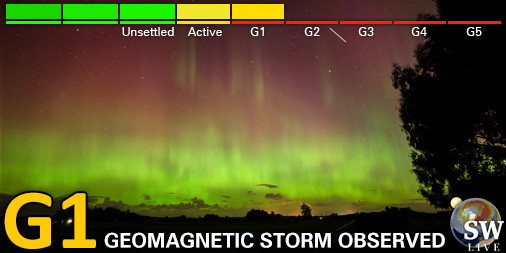Viewing archive of Monday, 21 September 2015
Daily bulletin on solar and geomagnetic activity from the SIDC
Issued: 2015 Sep 21 1230 UTC
SIDC Forecast
Solar flares
M-class flares expected (probability >=50%)
Geomagnetism
Quiet (A<20 and K<4)
Solar protons
Quiet
| 10cm flux | Ap | |
|---|---|---|
| 21 Sep 2015 | 117 | 010 |
| 22 Sep 2015 | 123 | 007 |
| 23 Sep 2015 | 129 | 009 |
Bulletin
Four active regions were reported by NOAA today, with two of them (NOAA ARs 2415 and 2420) having beta-gamma configurations of their photospheric magnetic field. After the M2.1 flare in the NOAA AR 2415 yesterday, the flaring activity became dominated by the NOAA AR 2420. It produced four C-class flares today, the strongest one being the C8.8 flare peaking at 05:18 UT. No Earth-directed CMEs were associated with these flares. We expect flaring activity on the M-level, mostly in the NOAA AR 2420. The solar proton flux at energies above 10 MeV decreased again after the peak yesterday evening, and is currently only slightly above the background. Although a further increase is not excluded due to the approach of the interplanetary shock driven by the CME associated with yesterday's M2.1 flare, we expect the proton flux to remain below the event threshold. A small equatorial coronal hole reached the solar central meridian today. The fast solar wind flow from this coronal hole is expected to arrive at the Earth on September 24. After the arrival of the interplanetary shock yesterday, the solar wind speed at the Earth is fluctuating between 500 and 600 km/s. The interplanetary magnetic field magnitude decreased down to 6-7 nT. The geomagnetic conditions are quiet to unsettled and are expected to remain so, with isolated intervals of active conditions possible but unlikely.
Today's estimated international sunspot number (ISN): 071, based on 18 stations.Solar indices for 20 Sep 2015
| Wolf number Catania | /// |
| 10cm solar flux | 110 |
| AK Chambon La Forêt | 043 |
| AK Wingst | 030 |
| Estimated Ap | 035 |
| Estimated international sunspot number | 062 - Based on 27 stations |
Noticeable events summary
| Day | Begin | Max | End | Loc | Strength | OP | 10cm | Catania/NOAA | Radio burst types |
|---|---|---|---|---|---|---|---|---|---|
| 20 | 1732 | 1803 | 1829 | S20W24 | M2.1 | 2N | 320 | 31/2415 | VI/2III/1II/1 |
Provided by the Solar Influences Data analysis Center© - SIDC - Processed by SpaceWeatherLive
All times in UTC
Current data suggests there is a high possibility for aurora to appear at the following high latitude regions in the near future
Rovaniemi, Sodankylä, UtsjokiKirkenes, Tromsø
Murmansk
Kiruna
Current data suggests there is a moderate possibility for aurora to appear at the following high latitude regions in the near future
TórshavnOulu
Trondheim
Arkhangelsk, Vorkuta
Luleå, Umeå
Current data suggests there is a slight possibility for aurora to appear at the following high latitude regions in the near future
KuopioBergen, Oslo
Sundsvall
Current data suggests there is a slight possibility for aurora to appear at the following middle latitude regions in the near future
Helsinki, Tampere, TurkuPetrozavodsk, Syktyvkar
Latest news
Latest forum messages
Support SpaceWeatherLive.com!
A lot of people come to SpaceWeatherLive to follow the Sun's activity or if there is aurora to be seen, but with more traffic comes higher server costs. Consider a donation if you enjoy SpaceWeatherLive so we can keep the website online!

Latest alerts
21:03 UTC - Hemispheric Power Index
The OVATION model predicts the Hemispheric Power Index to reach 75GW at 21:49 UTC
13:15 UTC - Geomagnetic activity
Minor G1 geomagnetic storm (Kp5) Threshold Reached: 13:07 UTC
12:33 UTC - Hemispheric Power Index
The OVATION model predicts the Hemispheric Power Index to reach 75GW at 13:21 UTC
00:15 UTC - Geomagnetic activity
Minor G1 geomagnetic storm (Kp5) Threshold Reached: 23:59 UTC
Thursday, 3 April 2025
20:15 UTC - Geomagnetic activity
Minor G1 geomagnetic storm (Kp5) Threshold Reached: 20:02 UTC
Space weather facts
| Last X-flare | 2025/03/28 | X1.1 |
| Last M-flare | 2025/04/01 | M2.5 |
| Last geomagnetic storm | 2025/03/27 | Kp5 (G1) |
| Spotless days | |
|---|---|
| Last spotless day | 2022/06/08 |
| Monthly mean Sunspot Number | |
|---|---|
| March 2025 | 134.2 -20.4 |
| April 2025 | 143 +8.8 |
| Last 30 days | 130.4 -16.1 |





